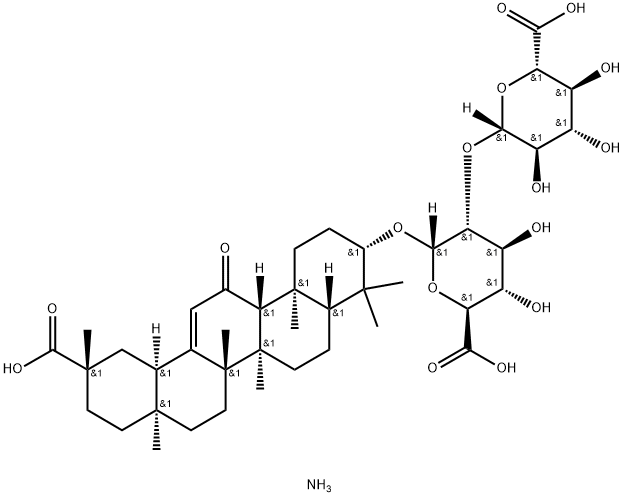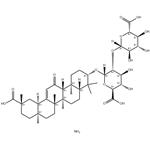§ 184.1408(a)(1) Licorice (glycyrrhiza) root is the dried and ground
rhizome and root portions of Glycyrrhiza glabra or other species of
glycyrrhiza. Licorice extract is that portion of the licorice root that
is, after maceration, extracted by boiling water. The extract can be
further purified by filtration and by treatment with acids and ethyl
alcohol. Licorice extract is sold as a liquid paste ("block"), or spraydried
powder. (2) Ammoniated glycyrrhizin is prepared from the
water extract of licorice root by acid precipitation followed by neutralization
with dilute ammonia. Monoammonium glycyrrhizinate
(C42H61016NH45H2O ) is prepared from ammoniated glycyrrhizin by
solvent extraction and separation techniques.
Licorice (glycyrrhiza) root is the dried and ground rhizome and root portions of Glycyrrhiza glabra or other species of glycyrrhiza Ammoniated glycyrrhizin is prepared from the water extract of licorice root by acid precipitation, followed by neutral- ization with dilute ammonia Monoammonium glycyrrhizinate (C42H62O16NH45H2O) is prepared from ammoniated glycyrrhizin by solvent extraction and separation techniques.
white to slightly yellow powder
pharmaceutical excipient, GRAS, sweetener
Glycyrrhizic acid ammonium salt is a flavoring and sweetening agent obtained from licorice flavonoids. It has a slight licorice flavor and an intense and rounded sweetness. It is soluble in water, glycerin, and propylene glycol and has good thermal stability but can degrade under prolonged heating. It is stable over a ph of 3.5–9 but could precipitate below ph of 3.5. It can be used in beverages, desserts, confectionary products, soups, and dressings.
Ammonium Glycyrrhizinate is used in the synthesis of polyion complex nanocarriers which may act as a template for the design of other negatively charged water-soluble drugs. Particularly for anti-infl
ammatory drugs with which Ammonium Glycyrrhizinate is associated.
ChEBI: Monoammonium glycyrrhizinate is an organic molecular entity.
Produced and qualified by HWI pharma services GmbH.
Exact content by quantitative NMR can be found on the certificate.
Biologically active constituent in the sweet root of Glycyrrhiza species (licorice). Antiviral.
Glycyrrhizin (GL) is a saponin-like compound that provides the main sweet flavourfor G. glabra (licorice), and it is commonly used in clinical treatment for itsoutstanding pharmacological action such as antitumour, anti-inflammatory andanti-oxidativeactions (Rebhun et al. 2015; Wu et al. 2015). Cai et al. (2017) triedto evaluate the anticancer properties of GA and GL against TNBC in combinationwith etoposide.
Moderately toxic by
intravenous route. An experimental
teratogen. Experimental reproductive
effects. Mutation data reported. When
heated to decomposition it emits toxic
fumes of NH3.
Crystallise the ammonium salt from glacial acetic acid, then dissolve it in ethanolic ammonia and evaporate. The pentahydrate forms needles from 75% aqueous EtOH, m 212-217o. The free acid crystallises from glacial acetic acid. [Karrer et al. Helv Chim Acta 4 100 1921, Lithgoe & Tripett J Chem Soc 1983, 1987 1950, Beilstein 18 IV 5156.]



